Fall Prevention Management: Evaluating Footwear Effectiveness
VerifiedAdded on 2022/10/03
|32
|6964
|15
Report
AI Summary
This report investigates the effectiveness of non-slip footwear in preventing falls among elderly patients, a critical health concern due to the associated morbidity and mortality. The report begins with an introduction highlighting the significance of fall prevention and the limitations of standard procedures. It formulates a clinical research question within the PICO framework, focusing on whether non-slip footwear reduces mortality rates compared to standard practices. The methodology includes a systematic review of literature from databases like MedLine, PubMed, and CINNAHL, using specific search terms, Boolean operators, and inclusion/exclusion criteria. The report analyzes nine relevant studies, discussing findings that support the use of non-slip footwear in reducing fall prevalence and injury rates. The studies emphasize the benefits of slip-resistant footwear designs, such as those with hybrid rubber outsoles, and the importance of considering these interventions in healthcare settings. The report concludes with a summary of the evidence, highlighting the potential for nurses to implement non-slip footwear as a cost-effective strategy to improve patient outcomes and reduce fall-related risks.
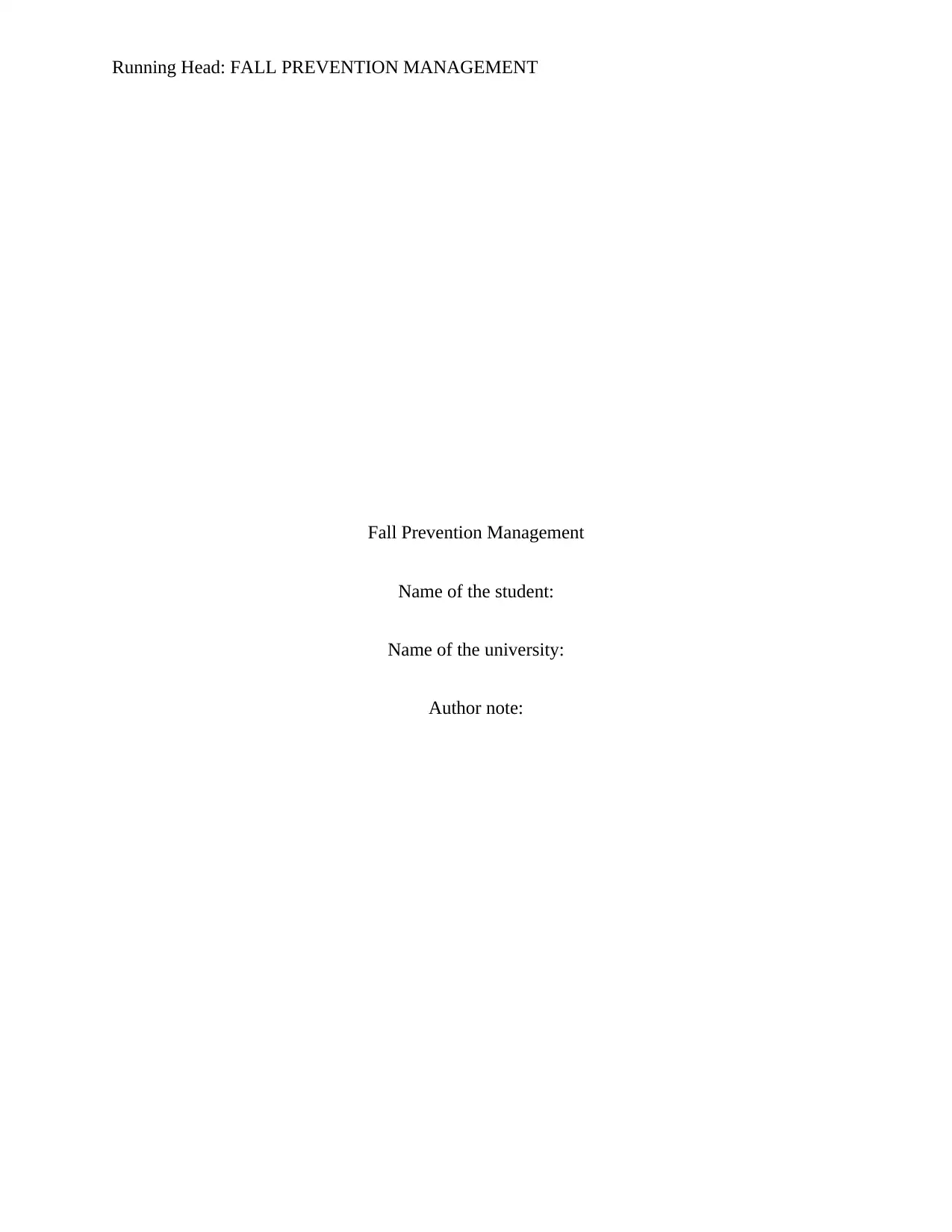
Running Head: FALL PREVENTION MANAGEMENT
Fall Prevention Management
Name of the student:
Name of the university:
Author note:
Fall Prevention Management
Name of the student:
Name of the university:
Author note:
Paraphrase This Document
Need a fresh take? Get an instant paraphrase of this document with our AI Paraphraser
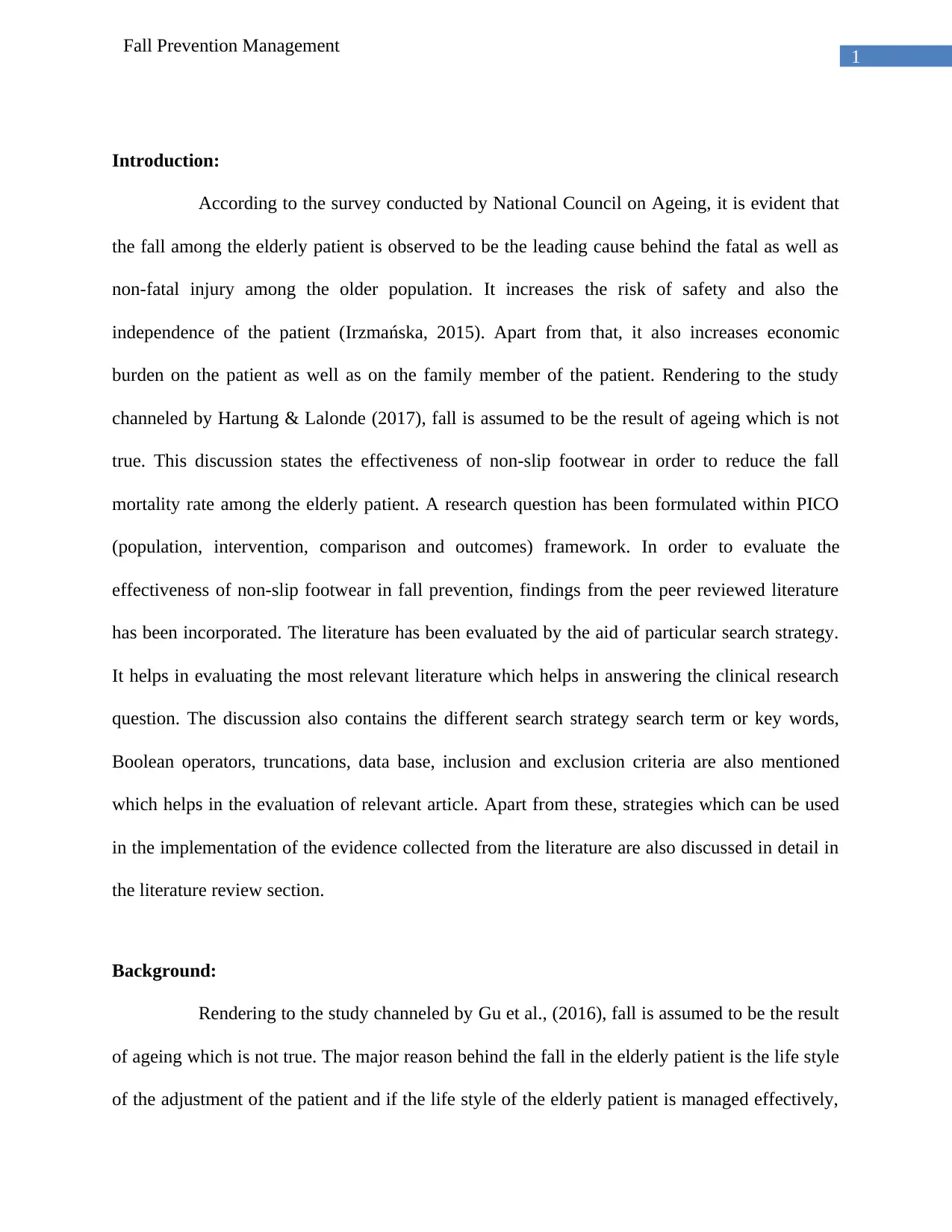
1
Fall Prevention Management
Introduction:
According to the survey conducted by National Council on Ageing, it is evident that
the fall among the elderly patient is observed to be the leading cause behind the fatal as well as
non-fatal injury among the older population. It increases the risk of safety and also the
independence of the patient (Irzmańska, 2015). Apart from that, it also increases economic
burden on the patient as well as on the family member of the patient. Rendering to the study
channeled by Hartung & Lalonde (2017), fall is assumed to be the result of ageing which is not
true. This discussion states the effectiveness of non-slip footwear in order to reduce the fall
mortality rate among the elderly patient. A research question has been formulated within PICO
(population, intervention, comparison and outcomes) framework. In order to evaluate the
effectiveness of non-slip footwear in fall prevention, findings from the peer reviewed literature
has been incorporated. The literature has been evaluated by the aid of particular search strategy.
It helps in evaluating the most relevant literature which helps in answering the clinical research
question. The discussion also contains the different search strategy search term or key words,
Boolean operators, truncations, data base, inclusion and exclusion criteria are also mentioned
which helps in the evaluation of relevant article. Apart from these, strategies which can be used
in the implementation of the evidence collected from the literature are also discussed in detail in
the literature review section.
Background:
Rendering to the study channeled by Gu et al., (2016), fall is assumed to be the result
of ageing which is not true. The major reason behind the fall in the elderly patient is the life style
of the adjustment of the patient and if the life style of the elderly patient is managed effectively,
Fall Prevention Management
Introduction:
According to the survey conducted by National Council on Ageing, it is evident that
the fall among the elderly patient is observed to be the leading cause behind the fatal as well as
non-fatal injury among the older population. It increases the risk of safety and also the
independence of the patient (Irzmańska, 2015). Apart from that, it also increases economic
burden on the patient as well as on the family member of the patient. Rendering to the study
channeled by Hartung & Lalonde (2017), fall is assumed to be the result of ageing which is not
true. This discussion states the effectiveness of non-slip footwear in order to reduce the fall
mortality rate among the elderly patient. A research question has been formulated within PICO
(population, intervention, comparison and outcomes) framework. In order to evaluate the
effectiveness of non-slip footwear in fall prevention, findings from the peer reviewed literature
has been incorporated. The literature has been evaluated by the aid of particular search strategy.
It helps in evaluating the most relevant literature which helps in answering the clinical research
question. The discussion also contains the different search strategy search term or key words,
Boolean operators, truncations, data base, inclusion and exclusion criteria are also mentioned
which helps in the evaluation of relevant article. Apart from these, strategies which can be used
in the implementation of the evidence collected from the literature are also discussed in detail in
the literature review section.
Background:
Rendering to the study channeled by Gu et al., (2016), fall is assumed to be the result
of ageing which is not true. The major reason behind the fall in the elderly patient is the life style
of the adjustment of the patient and if the life style of the elderly patient is managed effectively,
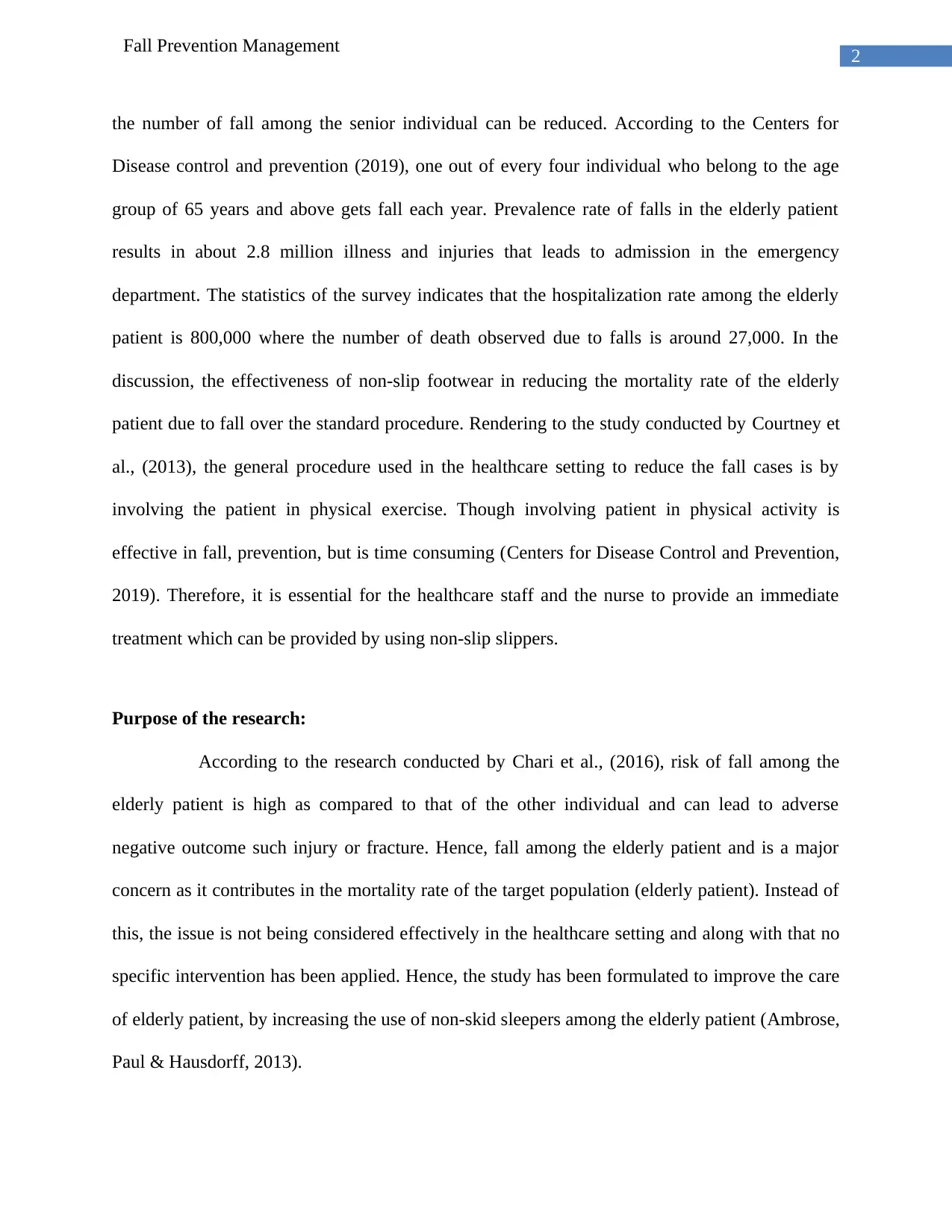
2
Fall Prevention Management
the number of fall among the senior individual can be reduced. According to the Centers for
Disease control and prevention (2019), one out of every four individual who belong to the age
group of 65 years and above gets fall each year. Prevalence rate of falls in the elderly patient
results in about 2.8 million illness and injuries that leads to admission in the emergency
department. The statistics of the survey indicates that the hospitalization rate among the elderly
patient is 800,000 where the number of death observed due to falls is around 27,000. In the
discussion, the effectiveness of non-slip footwear in reducing the mortality rate of the elderly
patient due to fall over the standard procedure. Rendering to the study conducted by Courtney et
al., (2013), the general procedure used in the healthcare setting to reduce the fall cases is by
involving the patient in physical exercise. Though involving patient in physical activity is
effective in fall, prevention, but is time consuming (Centers for Disease Control and Prevention,
2019). Therefore, it is essential for the healthcare staff and the nurse to provide an immediate
treatment which can be provided by using non-slip slippers.
Purpose of the research:
According to the research conducted by Chari et al., (2016), risk of fall among the
elderly patient is high as compared to that of the other individual and can lead to adverse
negative outcome such injury or fracture. Hence, fall among the elderly patient and is a major
concern as it contributes in the mortality rate of the target population (elderly patient). Instead of
this, the issue is not being considered effectively in the healthcare setting and along with that no
specific intervention has been applied. Hence, the study has been formulated to improve the care
of elderly patient, by increasing the use of non-skid sleepers among the elderly patient (Ambrose,
Paul & Hausdorff, 2013).
Fall Prevention Management
the number of fall among the senior individual can be reduced. According to the Centers for
Disease control and prevention (2019), one out of every four individual who belong to the age
group of 65 years and above gets fall each year. Prevalence rate of falls in the elderly patient
results in about 2.8 million illness and injuries that leads to admission in the emergency
department. The statistics of the survey indicates that the hospitalization rate among the elderly
patient is 800,000 where the number of death observed due to falls is around 27,000. In the
discussion, the effectiveness of non-slip footwear in reducing the mortality rate of the elderly
patient due to fall over the standard procedure. Rendering to the study conducted by Courtney et
al., (2013), the general procedure used in the healthcare setting to reduce the fall cases is by
involving the patient in physical exercise. Though involving patient in physical activity is
effective in fall, prevention, but is time consuming (Centers for Disease Control and Prevention,
2019). Therefore, it is essential for the healthcare staff and the nurse to provide an immediate
treatment which can be provided by using non-slip slippers.
Purpose of the research:
According to the research conducted by Chari et al., (2016), risk of fall among the
elderly patient is high as compared to that of the other individual and can lead to adverse
negative outcome such injury or fracture. Hence, fall among the elderly patient and is a major
concern as it contributes in the mortality rate of the target population (elderly patient). Instead of
this, the issue is not being considered effectively in the healthcare setting and along with that no
specific intervention has been applied. Hence, the study has been formulated to improve the care
of elderly patient, by increasing the use of non-skid sleepers among the elderly patient (Ambrose,
Paul & Hausdorff, 2013).
⊘ This is a preview!⊘
Do you want full access?
Subscribe today to unlock all pages.

Trusted by 1+ million students worldwide
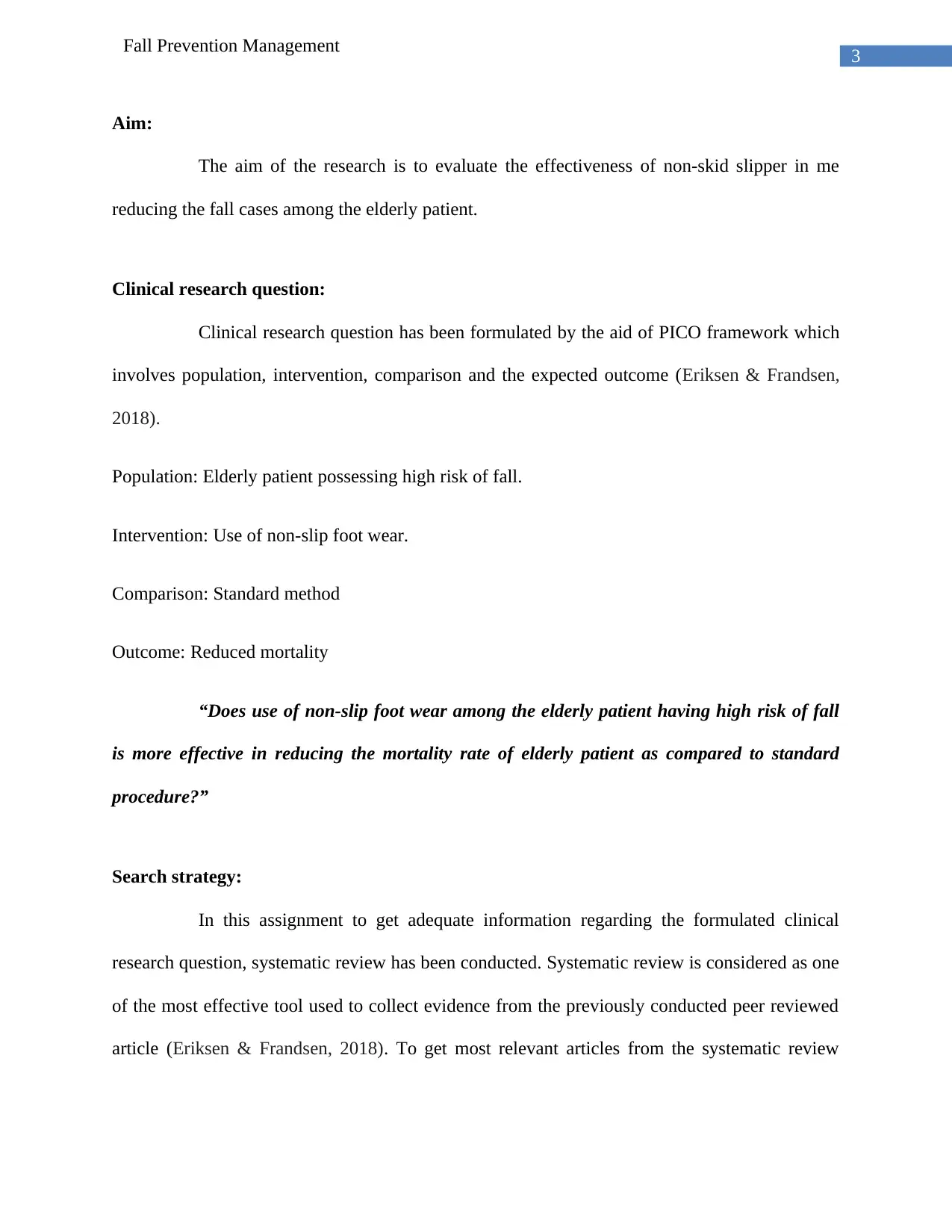
3
Fall Prevention Management
Aim:
The aim of the research is to evaluate the effectiveness of non-skid slipper in me
reducing the fall cases among the elderly patient.
Clinical research question:
Clinical research question has been formulated by the aid of PICO framework which
involves population, intervention, comparison and the expected outcome (Eriksen & Frandsen,
2018).
Population: Elderly patient possessing high risk of fall.
Intervention: Use of non-slip foot wear.
Comparison: Standard method
Outcome: Reduced mortality
“Does use of non-slip foot wear among the elderly patient having high risk of fall
is more effective in reducing the mortality rate of elderly patient as compared to standard
procedure?”
Search strategy:
In this assignment to get adequate information regarding the formulated clinical
research question, systematic review has been conducted. Systematic review is considered as one
of the most effective tool used to collect evidence from the previously conducted peer reviewed
article (Eriksen & Frandsen, 2018). To get most relevant articles from the systematic review
Fall Prevention Management
Aim:
The aim of the research is to evaluate the effectiveness of non-skid slipper in me
reducing the fall cases among the elderly patient.
Clinical research question:
Clinical research question has been formulated by the aid of PICO framework which
involves population, intervention, comparison and the expected outcome (Eriksen & Frandsen,
2018).
Population: Elderly patient possessing high risk of fall.
Intervention: Use of non-slip foot wear.
Comparison: Standard method
Outcome: Reduced mortality
“Does use of non-slip foot wear among the elderly patient having high risk of fall
is more effective in reducing the mortality rate of elderly patient as compared to standard
procedure?”
Search strategy:
In this assignment to get adequate information regarding the formulated clinical
research question, systematic review has been conducted. Systematic review is considered as one
of the most effective tool used to collect evidence from the previously conducted peer reviewed
article (Eriksen & Frandsen, 2018). To get most relevant articles from the systematic review
Paraphrase This Document
Need a fresh take? Get an instant paraphrase of this document with our AI Paraphraser
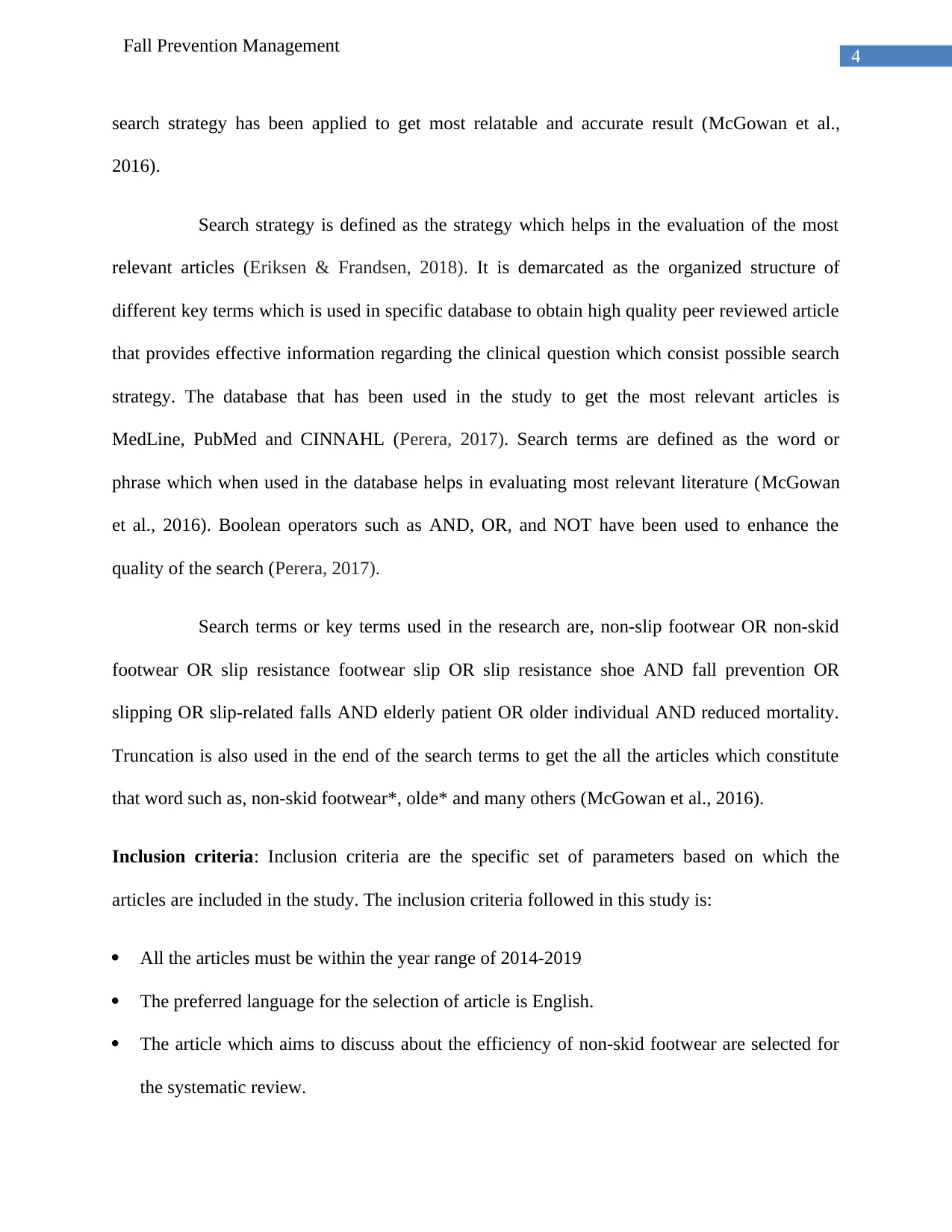
4
Fall Prevention Management
search strategy has been applied to get most relatable and accurate result (McGowan et al.,
2016).
Search strategy is defined as the strategy which helps in the evaluation of the most
relevant articles (Eriksen & Frandsen, 2018). It is demarcated as the organized structure of
different key terms which is used in specific database to obtain high quality peer reviewed article
that provides effective information regarding the clinical question which consist possible search
strategy. The database that has been used in the study to get the most relevant articles is
MedLine, PubMed and CINNAHL (Perera, 2017). Search terms are defined as the word or
phrase which when used in the database helps in evaluating most relevant literature (McGowan
et al., 2016). Boolean operators such as AND, OR, and NOT have been used to enhance the
quality of the search (Perera, 2017).
Search terms or key terms used in the research are, non-slip footwear OR non-skid
footwear OR slip resistance footwear slip OR slip resistance shoe AND fall prevention OR
slipping OR slip-related falls AND elderly patient OR older individual AND reduced mortality.
Truncation is also used in the end of the search terms to get the all the articles which constitute
that word such as, non-skid footwear*, olde* and many others (McGowan et al., 2016).
Inclusion criteria: Inclusion criteria are the specific set of parameters based on which the
articles are included in the study. The inclusion criteria followed in this study is:
All the articles must be within the year range of 2014-2019
The preferred language for the selection of article is English.
The article which aims to discuss about the efficiency of non-skid footwear are selected for
the systematic review.
Fall Prevention Management
search strategy has been applied to get most relatable and accurate result (McGowan et al.,
2016).
Search strategy is defined as the strategy which helps in the evaluation of the most
relevant articles (Eriksen & Frandsen, 2018). It is demarcated as the organized structure of
different key terms which is used in specific database to obtain high quality peer reviewed article
that provides effective information regarding the clinical question which consist possible search
strategy. The database that has been used in the study to get the most relevant articles is
MedLine, PubMed and CINNAHL (Perera, 2017). Search terms are defined as the word or
phrase which when used in the database helps in evaluating most relevant literature (McGowan
et al., 2016). Boolean operators such as AND, OR, and NOT have been used to enhance the
quality of the search (Perera, 2017).
Search terms or key terms used in the research are, non-slip footwear OR non-skid
footwear OR slip resistance footwear slip OR slip resistance shoe AND fall prevention OR
slipping OR slip-related falls AND elderly patient OR older individual AND reduced mortality.
Truncation is also used in the end of the search terms to get the all the articles which constitute
that word such as, non-skid footwear*, olde* and many others (McGowan et al., 2016).
Inclusion criteria: Inclusion criteria are the specific set of parameters based on which the
articles are included in the study. The inclusion criteria followed in this study is:
All the articles must be within the year range of 2014-2019
The preferred language for the selection of article is English.
The article which aims to discuss about the efficiency of non-skid footwear are selected for
the systematic review.
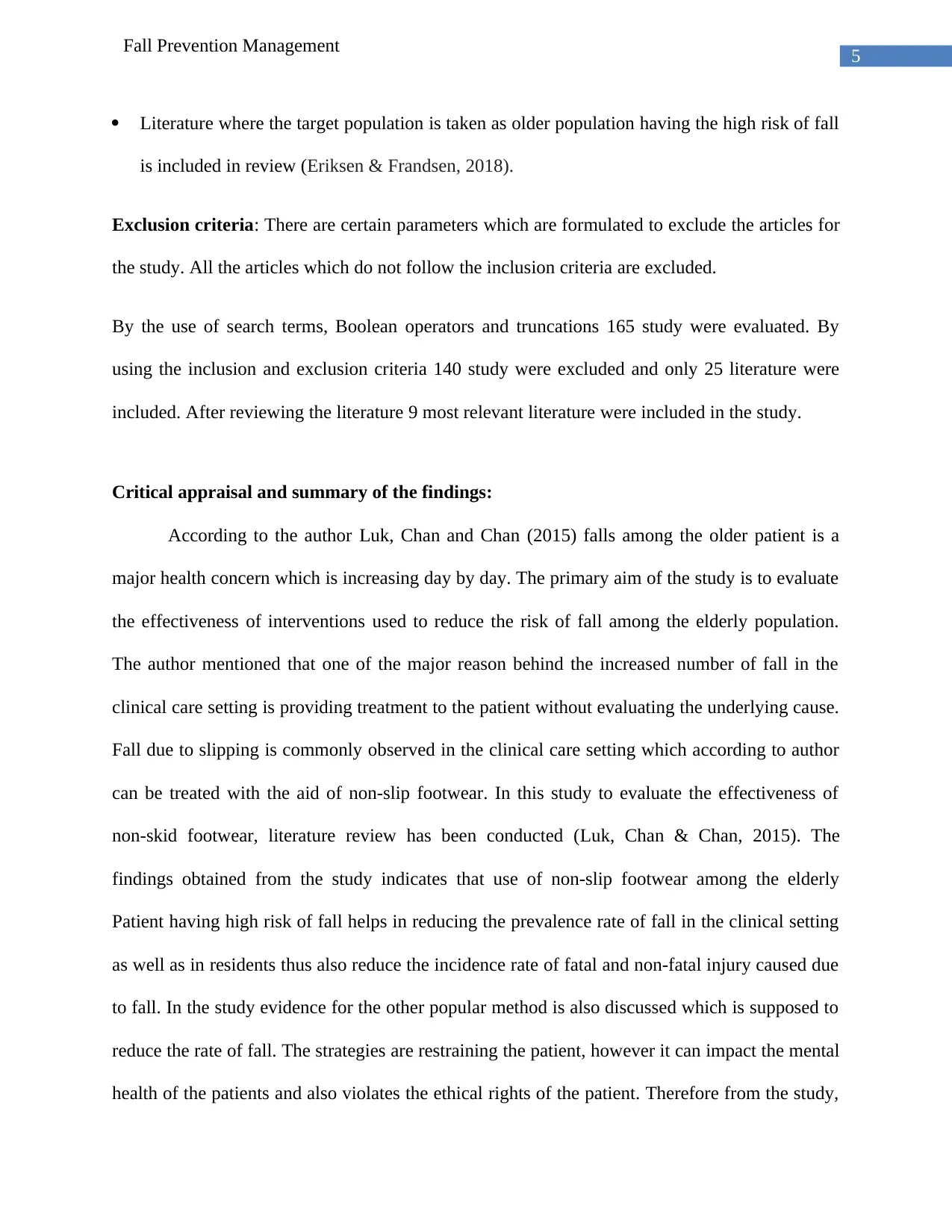
5
Fall Prevention Management
Literature where the target population is taken as older population having the high risk of fall
is included in review (Eriksen & Frandsen, 2018).
Exclusion criteria: There are certain parameters which are formulated to exclude the articles for
the study. All the articles which do not follow the inclusion criteria are excluded.
By the use of search terms, Boolean operators and truncations 165 study were evaluated. By
using the inclusion and exclusion criteria 140 study were excluded and only 25 literature were
included. After reviewing the literature 9 most relevant literature were included in the study.
Critical appraisal and summary of the findings:
According to the author Luk, Chan and Chan (2015) falls among the older patient is a
major health concern which is increasing day by day. The primary aim of the study is to evaluate
the effectiveness of interventions used to reduce the risk of fall among the elderly population.
The author mentioned that one of the major reason behind the increased number of fall in the
clinical care setting is providing treatment to the patient without evaluating the underlying cause.
Fall due to slipping is commonly observed in the clinical care setting which according to author
can be treated with the aid of non-slip footwear. In this study to evaluate the effectiveness of
non-skid footwear, literature review has been conducted (Luk, Chan & Chan, 2015). The
findings obtained from the study indicates that use of non-slip footwear among the elderly
Patient having high risk of fall helps in reducing the prevalence rate of fall in the clinical setting
as well as in residents thus also reduce the incidence rate of fatal and non-fatal injury caused due
to fall. In the study evidence for the other popular method is also discussed which is supposed to
reduce the rate of fall. The strategies are restraining the patient, however it can impact the mental
health of the patients and also violates the ethical rights of the patient. Therefore from the study,
Fall Prevention Management
Literature where the target population is taken as older population having the high risk of fall
is included in review (Eriksen & Frandsen, 2018).
Exclusion criteria: There are certain parameters which are formulated to exclude the articles for
the study. All the articles which do not follow the inclusion criteria are excluded.
By the use of search terms, Boolean operators and truncations 165 study were evaluated. By
using the inclusion and exclusion criteria 140 study were excluded and only 25 literature were
included. After reviewing the literature 9 most relevant literature were included in the study.
Critical appraisal and summary of the findings:
According to the author Luk, Chan and Chan (2015) falls among the older patient is a
major health concern which is increasing day by day. The primary aim of the study is to evaluate
the effectiveness of interventions used to reduce the risk of fall among the elderly population.
The author mentioned that one of the major reason behind the increased number of fall in the
clinical care setting is providing treatment to the patient without evaluating the underlying cause.
Fall due to slipping is commonly observed in the clinical care setting which according to author
can be treated with the aid of non-slip footwear. In this study to evaluate the effectiveness of
non-skid footwear, literature review has been conducted (Luk, Chan & Chan, 2015). The
findings obtained from the study indicates that use of non-slip footwear among the elderly
Patient having high risk of fall helps in reducing the prevalence rate of fall in the clinical setting
as well as in residents thus also reduce the incidence rate of fatal and non-fatal injury caused due
to fall. In the study evidence for the other popular method is also discussed which is supposed to
reduce the rate of fall. The strategies are restraining the patient, however it can impact the mental
health of the patients and also violates the ethical rights of the patient. Therefore from the study,
⊘ This is a preview!⊘
Do you want full access?
Subscribe today to unlock all pages.

Trusted by 1+ million students worldwide
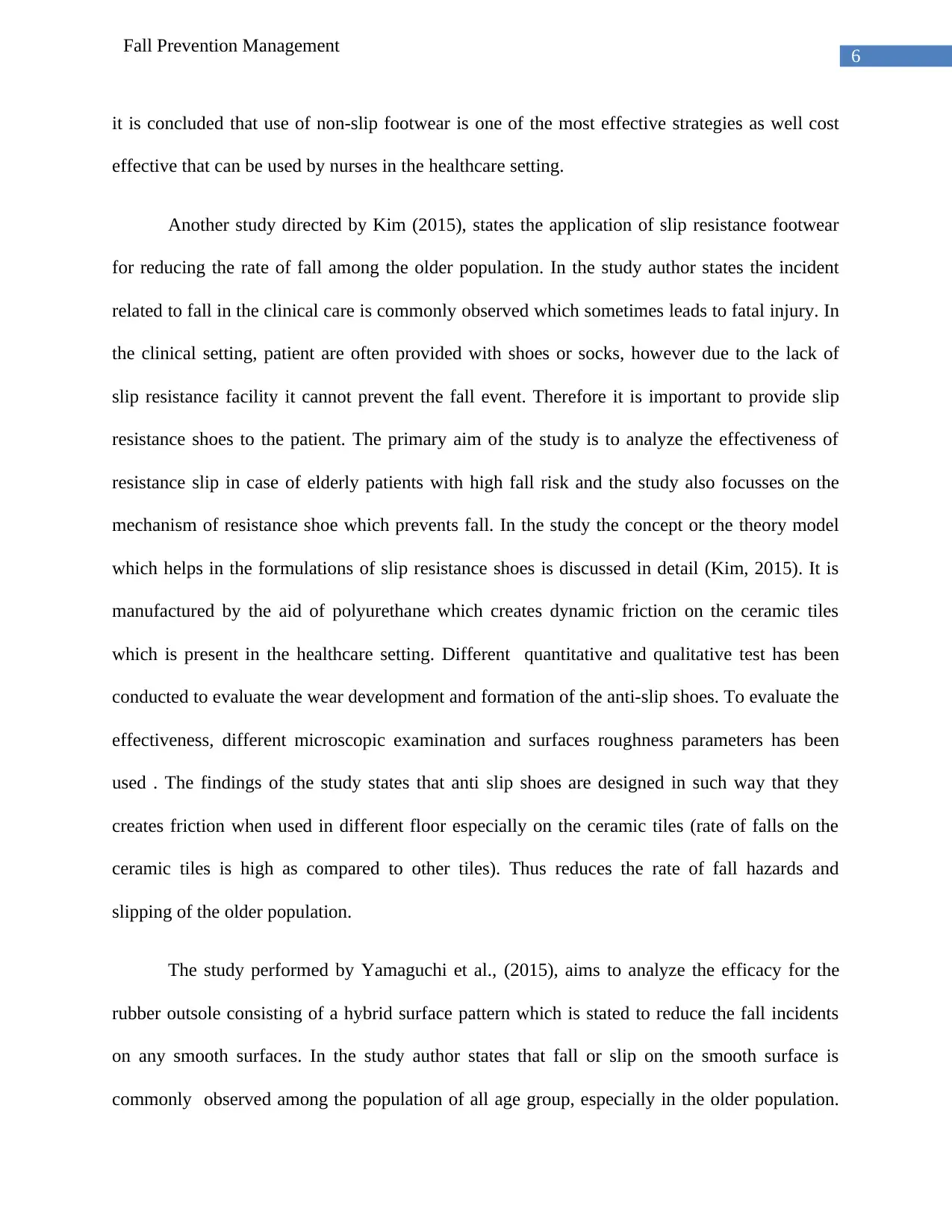
6
Fall Prevention Management
it is concluded that use of non-slip footwear is one of the most effective strategies as well cost
effective that can be used by nurses in the healthcare setting.
Another study directed by Kim (2015), states the application of slip resistance footwear
for reducing the rate of fall among the older population. In the study author states the incident
related to fall in the clinical care is commonly observed which sometimes leads to fatal injury. In
the clinical setting, patient are often provided with shoes or socks, however due to the lack of
slip resistance facility it cannot prevent the fall event. Therefore it is important to provide slip
resistance shoes to the patient. The primary aim of the study is to analyze the effectiveness of
resistance slip in case of elderly patients with high fall risk and the study also focusses on the
mechanism of resistance shoe which prevents fall. In the study the concept or the theory model
which helps in the formulations of slip resistance shoes is discussed in detail (Kim, 2015). It is
manufactured by the aid of polyurethane which creates dynamic friction on the ceramic tiles
which is present in the healthcare setting. Different quantitative and qualitative test has been
conducted to evaluate the wear development and formation of the anti-slip shoes. To evaluate the
effectiveness, different microscopic examination and surfaces roughness parameters has been
used . The findings of the study states that anti slip shoes are designed in such way that they
creates friction when used in different floor especially on the ceramic tiles (rate of falls on the
ceramic tiles is high as compared to other tiles). Thus reduces the rate of fall hazards and
slipping of the older population.
The study performed by Yamaguchi et al., (2015), aims to analyze the efficacy for the
rubber outsole consisting of a hybrid surface pattern which is stated to reduce the fall incidents
on any smooth surfaces. In the study author states that fall or slip on the smooth surface is
commonly observed among the population of all age group, especially in the older population.
Fall Prevention Management
it is concluded that use of non-slip footwear is one of the most effective strategies as well cost
effective that can be used by nurses in the healthcare setting.
Another study directed by Kim (2015), states the application of slip resistance footwear
for reducing the rate of fall among the older population. In the study author states the incident
related to fall in the clinical care is commonly observed which sometimes leads to fatal injury. In
the clinical setting, patient are often provided with shoes or socks, however due to the lack of
slip resistance facility it cannot prevent the fall event. Therefore it is important to provide slip
resistance shoes to the patient. The primary aim of the study is to analyze the effectiveness of
resistance slip in case of elderly patients with high fall risk and the study also focusses on the
mechanism of resistance shoe which prevents fall. In the study the concept or the theory model
which helps in the formulations of slip resistance shoes is discussed in detail (Kim, 2015). It is
manufactured by the aid of polyurethane which creates dynamic friction on the ceramic tiles
which is present in the healthcare setting. Different quantitative and qualitative test has been
conducted to evaluate the wear development and formation of the anti-slip shoes. To evaluate the
effectiveness, different microscopic examination and surfaces roughness parameters has been
used . The findings of the study states that anti slip shoes are designed in such way that they
creates friction when used in different floor especially on the ceramic tiles (rate of falls on the
ceramic tiles is high as compared to other tiles). Thus reduces the rate of fall hazards and
slipping of the older population.
The study performed by Yamaguchi et al., (2015), aims to analyze the efficacy for the
rubber outsole consisting of a hybrid surface pattern which is stated to reduce the fall incidents
on any smooth surfaces. In the study author states that fall or slip on the smooth surface is
commonly observed among the population of all age group, especially in the older population.
Paraphrase This Document
Need a fresh take? Get an instant paraphrase of this document with our AI Paraphraser
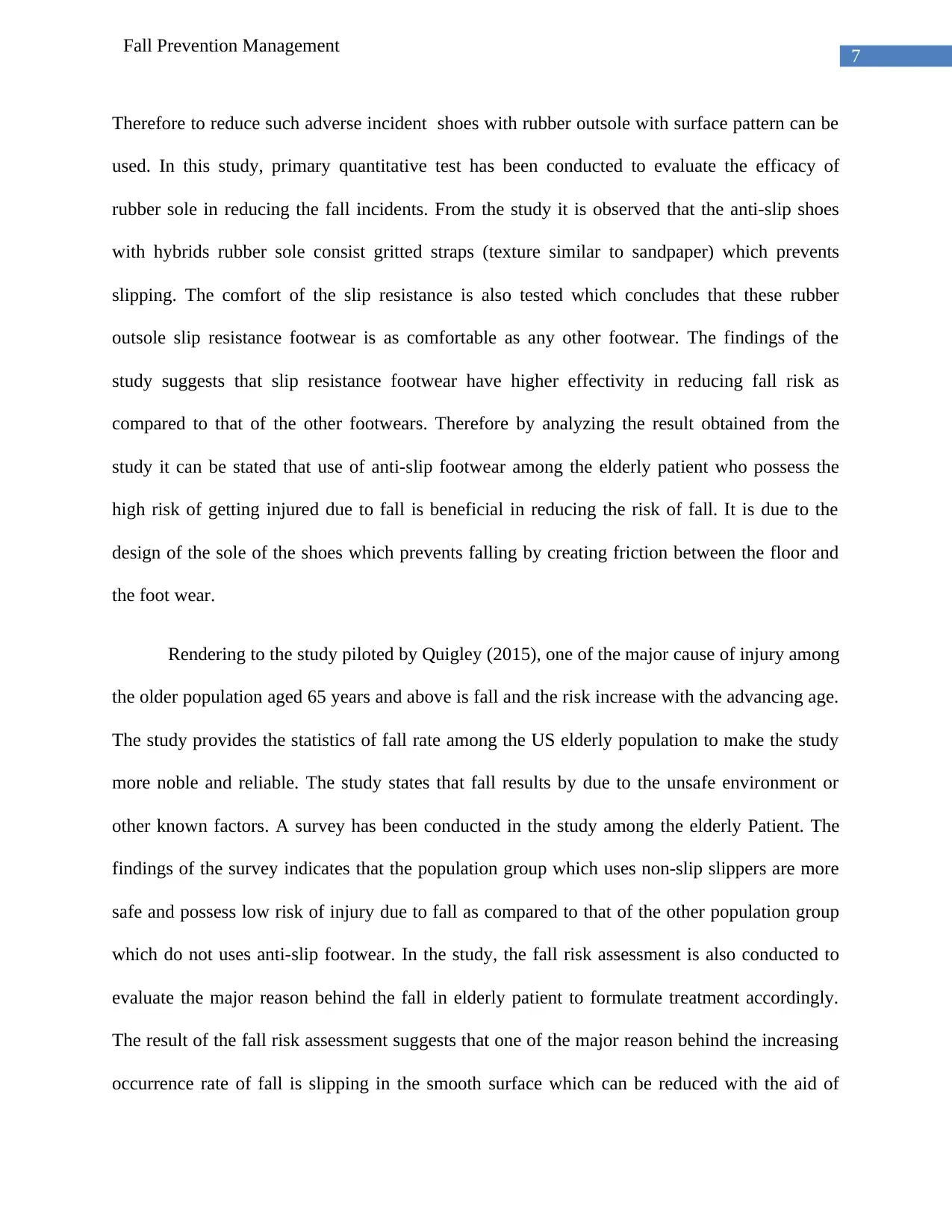
7
Fall Prevention Management
Therefore to reduce such adverse incident shoes with rubber outsole with surface pattern can be
used. In this study, primary quantitative test has been conducted to evaluate the efficacy of
rubber sole in reducing the fall incidents. From the study it is observed that the anti-slip shoes
with hybrids rubber sole consist gritted straps (texture similar to sandpaper) which prevents
slipping. The comfort of the slip resistance is also tested which concludes that these rubber
outsole slip resistance footwear is as comfortable as any other footwear. The findings of the
study suggests that slip resistance footwear have higher effectivity in reducing fall risk as
compared to that of the other footwears. Therefore by analyzing the result obtained from the
study it can be stated that use of anti-slip footwear among the elderly patient who possess the
high risk of getting injured due to fall is beneficial in reducing the risk of fall. It is due to the
design of the sole of the shoes which prevents falling by creating friction between the floor and
the foot wear.
Rendering to the study piloted by Quigley (2015), one of the major cause of injury among
the older population aged 65 years and above is fall and the risk increase with the advancing age.
The study provides the statistics of fall rate among the US elderly population to make the study
more noble and reliable. The study states that fall results by due to the unsafe environment or
other known factors. A survey has been conducted in the study among the elderly Patient. The
findings of the survey indicates that the population group which uses non-slip slippers are more
safe and possess low risk of injury due to fall as compared to that of the other population group
which do not uses anti-slip footwear. In the study, the fall risk assessment is also conducted to
evaluate the major reason behind the fall in elderly patient to formulate treatment accordingly.
The result of the fall risk assessment suggests that one of the major reason behind the increasing
occurrence rate of fall is slipping in the smooth surface which can be reduced with the aid of
Fall Prevention Management
Therefore to reduce such adverse incident shoes with rubber outsole with surface pattern can be
used. In this study, primary quantitative test has been conducted to evaluate the efficacy of
rubber sole in reducing the fall incidents. From the study it is observed that the anti-slip shoes
with hybrids rubber sole consist gritted straps (texture similar to sandpaper) which prevents
slipping. The comfort of the slip resistance is also tested which concludes that these rubber
outsole slip resistance footwear is as comfortable as any other footwear. The findings of the
study suggests that slip resistance footwear have higher effectivity in reducing fall risk as
compared to that of the other footwears. Therefore by analyzing the result obtained from the
study it can be stated that use of anti-slip footwear among the elderly patient who possess the
high risk of getting injured due to fall is beneficial in reducing the risk of fall. It is due to the
design of the sole of the shoes which prevents falling by creating friction between the floor and
the foot wear.
Rendering to the study piloted by Quigley (2015), one of the major cause of injury among
the older population aged 65 years and above is fall and the risk increase with the advancing age.
The study provides the statistics of fall rate among the US elderly population to make the study
more noble and reliable. The study states that fall results by due to the unsafe environment or
other known factors. A survey has been conducted in the study among the elderly Patient. The
findings of the survey indicates that the population group which uses non-slip slippers are more
safe and possess low risk of injury due to fall as compared to that of the other population group
which do not uses anti-slip footwear. In the study, the fall risk assessment is also conducted to
evaluate the major reason behind the fall in elderly patient to formulate treatment accordingly.
The result of the fall risk assessment suggests that one of the major reason behind the increasing
occurrence rate of fall is slipping in the smooth surface which can be reduced with the aid of
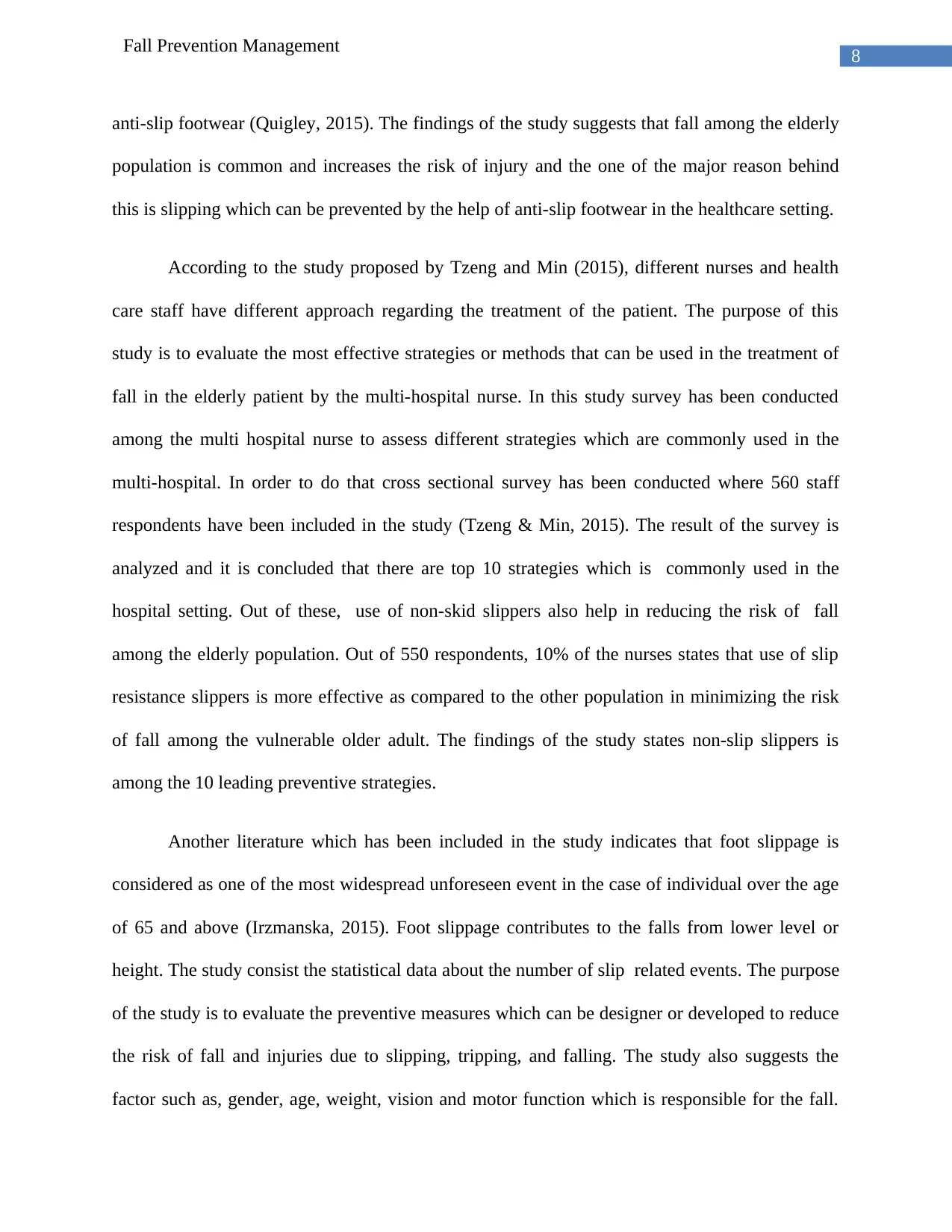
8
Fall Prevention Management
anti-slip footwear (Quigley, 2015). The findings of the study suggests that fall among the elderly
population is common and increases the risk of injury and the one of the major reason behind
this is slipping which can be prevented by the help of anti-slip footwear in the healthcare setting.
According to the study proposed by Tzeng and Min (2015), different nurses and health
care staff have different approach regarding the treatment of the patient. The purpose of this
study is to evaluate the most effective strategies or methods that can be used in the treatment of
fall in the elderly patient by the multi-hospital nurse. In this study survey has been conducted
among the multi hospital nurse to assess different strategies which are commonly used in the
multi-hospital. In order to do that cross sectional survey has been conducted where 560 staff
respondents have been included in the study (Tzeng & Min, 2015). The result of the survey is
analyzed and it is concluded that there are top 10 strategies which is commonly used in the
hospital setting. Out of these, use of non-skid slippers also help in reducing the risk of fall
among the elderly population. Out of 550 respondents, 10% of the nurses states that use of slip
resistance slippers is more effective as compared to the other population in minimizing the risk
of fall among the vulnerable older adult. The findings of the study states non-slip slippers is
among the 10 leading preventive strategies.
Another literature which has been included in the study indicates that foot slippage is
considered as one of the most widespread unforeseen event in the case of individual over the age
of 65 and above (Irzmanska, 2015). Foot slippage contributes to the falls from lower level or
height. The study consist the statistical data about the number of slip related events. The purpose
of the study is to evaluate the preventive measures which can be designer or developed to reduce
the risk of fall and injuries due to slipping, tripping, and falling. The study also suggests the
factor such as, gender, age, weight, vision and motor function which is responsible for the fall.
Fall Prevention Management
anti-slip footwear (Quigley, 2015). The findings of the study suggests that fall among the elderly
population is common and increases the risk of injury and the one of the major reason behind
this is slipping which can be prevented by the help of anti-slip footwear in the healthcare setting.
According to the study proposed by Tzeng and Min (2015), different nurses and health
care staff have different approach regarding the treatment of the patient. The purpose of this
study is to evaluate the most effective strategies or methods that can be used in the treatment of
fall in the elderly patient by the multi-hospital nurse. In this study survey has been conducted
among the multi hospital nurse to assess different strategies which are commonly used in the
multi-hospital. In order to do that cross sectional survey has been conducted where 560 staff
respondents have been included in the study (Tzeng & Min, 2015). The result of the survey is
analyzed and it is concluded that there are top 10 strategies which is commonly used in the
hospital setting. Out of these, use of non-skid slippers also help in reducing the risk of fall
among the elderly population. Out of 550 respondents, 10% of the nurses states that use of slip
resistance slippers is more effective as compared to the other population in minimizing the risk
of fall among the vulnerable older adult. The findings of the study states non-slip slippers is
among the 10 leading preventive strategies.
Another literature which has been included in the study indicates that foot slippage is
considered as one of the most widespread unforeseen event in the case of individual over the age
of 65 and above (Irzmanska, 2015). Foot slippage contributes to the falls from lower level or
height. The study consist the statistical data about the number of slip related events. The purpose
of the study is to evaluate the preventive measures which can be designer or developed to reduce
the risk of fall and injuries due to slipping, tripping, and falling. The study also suggests the
factor such as, gender, age, weight, vision and motor function which is responsible for the fall.
⊘ This is a preview!⊘
Do you want full access?
Subscribe today to unlock all pages.

Trusted by 1+ million students worldwide
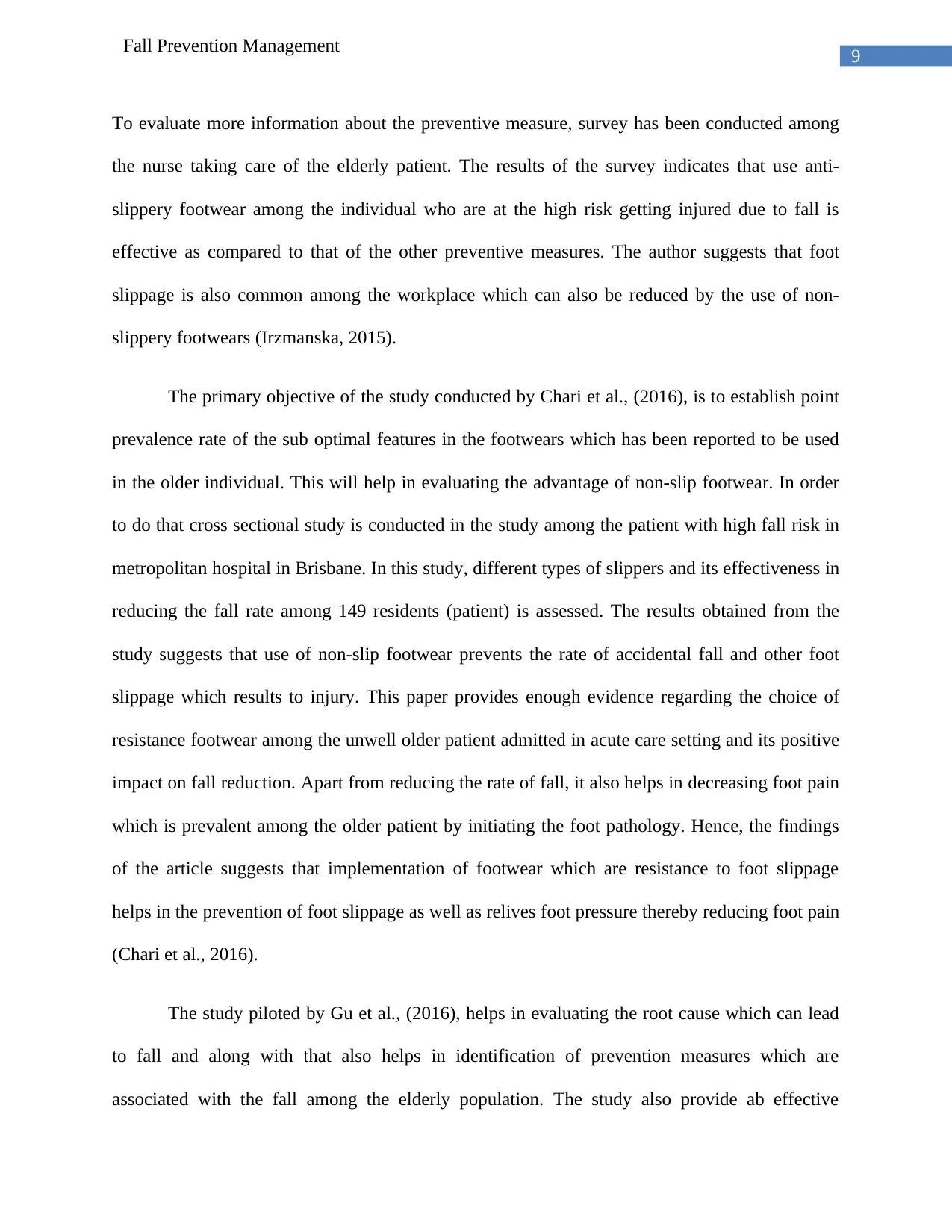
9
Fall Prevention Management
To evaluate more information about the preventive measure, survey has been conducted among
the nurse taking care of the elderly patient. The results of the survey indicates that use anti-
slippery footwear among the individual who are at the high risk getting injured due to fall is
effective as compared to that of the other preventive measures. The author suggests that foot
slippage is also common among the workplace which can also be reduced by the use of non-
slippery footwears (Irzmanska, 2015).
The primary objective of the study conducted by Chari et al., (2016), is to establish point
prevalence rate of the sub optimal features in the footwears which has been reported to be used
in the older individual. This will help in evaluating the advantage of non-slip footwear. In order
to do that cross sectional study is conducted in the study among the patient with high fall risk in
metropolitan hospital in Brisbane. In this study, different types of slippers and its effectiveness in
reducing the fall rate among 149 residents (patient) is assessed. The results obtained from the
study suggests that use of non-slip footwear prevents the rate of accidental fall and other foot
slippage which results to injury. This paper provides enough evidence regarding the choice of
resistance footwear among the unwell older patient admitted in acute care setting and its positive
impact on fall reduction. Apart from reducing the rate of fall, it also helps in decreasing foot pain
which is prevalent among the older patient by initiating the foot pathology. Hence, the findings
of the article suggests that implementation of footwear which are resistance to foot slippage
helps in the prevention of foot slippage as well as relives foot pressure thereby reducing foot pain
(Chari et al., 2016).
The study piloted by Gu et al., (2016), helps in evaluating the root cause which can lead
to fall and along with that also helps in identification of prevention measures which are
associated with the fall among the elderly population. The study also provide ab effective
Fall Prevention Management
To evaluate more information about the preventive measure, survey has been conducted among
the nurse taking care of the elderly patient. The results of the survey indicates that use anti-
slippery footwear among the individual who are at the high risk getting injured due to fall is
effective as compared to that of the other preventive measures. The author suggests that foot
slippage is also common among the workplace which can also be reduced by the use of non-
slippery footwears (Irzmanska, 2015).
The primary objective of the study conducted by Chari et al., (2016), is to establish point
prevalence rate of the sub optimal features in the footwears which has been reported to be used
in the older individual. This will help in evaluating the advantage of non-slip footwear. In order
to do that cross sectional study is conducted in the study among the patient with high fall risk in
metropolitan hospital in Brisbane. In this study, different types of slippers and its effectiveness in
reducing the fall rate among 149 residents (patient) is assessed. The results obtained from the
study suggests that use of non-slip footwear prevents the rate of accidental fall and other foot
slippage which results to injury. This paper provides enough evidence regarding the choice of
resistance footwear among the unwell older patient admitted in acute care setting and its positive
impact on fall reduction. Apart from reducing the rate of fall, it also helps in decreasing foot pain
which is prevalent among the older patient by initiating the foot pathology. Hence, the findings
of the article suggests that implementation of footwear which are resistance to foot slippage
helps in the prevention of foot slippage as well as relives foot pressure thereby reducing foot pain
(Chari et al., 2016).
The study piloted by Gu et al., (2016), helps in evaluating the root cause which can lead
to fall and along with that also helps in identification of prevention measures which are
associated with the fall among the elderly population. The study also provide ab effective
Paraphrase This Document
Need a fresh take? Get an instant paraphrase of this document with our AI Paraphraser
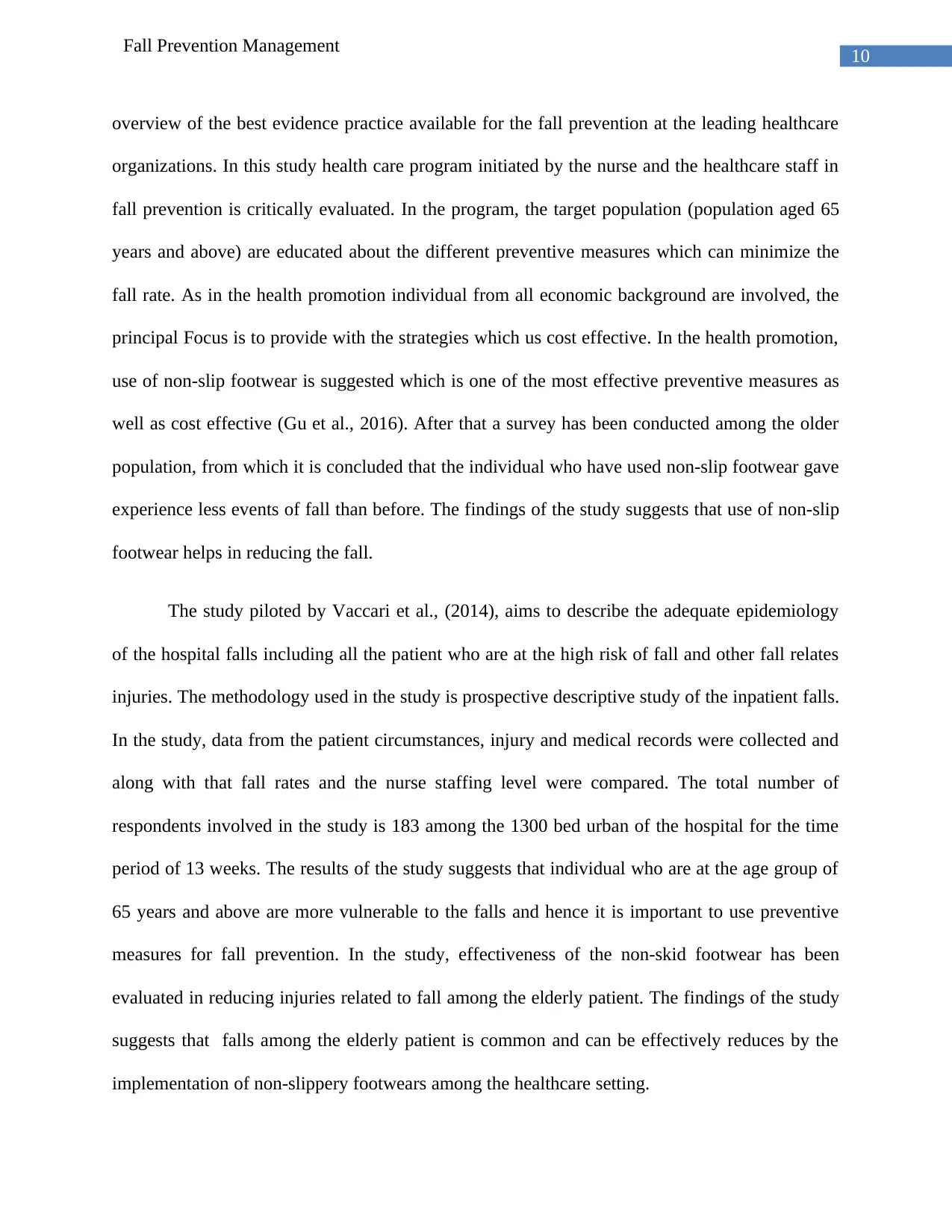
10
Fall Prevention Management
overview of the best evidence practice available for the fall prevention at the leading healthcare
organizations. In this study health care program initiated by the nurse and the healthcare staff in
fall prevention is critically evaluated. In the program, the target population (population aged 65
years and above) are educated about the different preventive measures which can minimize the
fall rate. As in the health promotion individual from all economic background are involved, the
principal Focus is to provide with the strategies which us cost effective. In the health promotion,
use of non-slip footwear is suggested which is one of the most effective preventive measures as
well as cost effective (Gu et al., 2016). After that a survey has been conducted among the older
population, from which it is concluded that the individual who have used non-slip footwear gave
experience less events of fall than before. The findings of the study suggests that use of non-slip
footwear helps in reducing the fall.
The study piloted by Vaccari et al., (2014), aims to describe the adequate epidemiology
of the hospital falls including all the patient who are at the high risk of fall and other fall relates
injuries. The methodology used in the study is prospective descriptive study of the inpatient falls.
In the study, data from the patient circumstances, injury and medical records were collected and
along with that fall rates and the nurse staffing level were compared. The total number of
respondents involved in the study is 183 among the 1300 bed urban of the hospital for the time
period of 13 weeks. The results of the study suggests that individual who are at the age group of
65 years and above are more vulnerable to the falls and hence it is important to use preventive
measures for fall prevention. In the study, effectiveness of the non-skid footwear has been
evaluated in reducing injuries related to fall among the elderly patient. The findings of the study
suggests that falls among the elderly patient is common and can be effectively reduces by the
implementation of non-slippery footwears among the healthcare setting.
Fall Prevention Management
overview of the best evidence practice available for the fall prevention at the leading healthcare
organizations. In this study health care program initiated by the nurse and the healthcare staff in
fall prevention is critically evaluated. In the program, the target population (population aged 65
years and above) are educated about the different preventive measures which can minimize the
fall rate. As in the health promotion individual from all economic background are involved, the
principal Focus is to provide with the strategies which us cost effective. In the health promotion,
use of non-slip footwear is suggested which is one of the most effective preventive measures as
well as cost effective (Gu et al., 2016). After that a survey has been conducted among the older
population, from which it is concluded that the individual who have used non-slip footwear gave
experience less events of fall than before. The findings of the study suggests that use of non-slip
footwear helps in reducing the fall.
The study piloted by Vaccari et al., (2014), aims to describe the adequate epidemiology
of the hospital falls including all the patient who are at the high risk of fall and other fall relates
injuries. The methodology used in the study is prospective descriptive study of the inpatient falls.
In the study, data from the patient circumstances, injury and medical records were collected and
along with that fall rates and the nurse staffing level were compared. The total number of
respondents involved in the study is 183 among the 1300 bed urban of the hospital for the time
period of 13 weeks. The results of the study suggests that individual who are at the age group of
65 years and above are more vulnerable to the falls and hence it is important to use preventive
measures for fall prevention. In the study, effectiveness of the non-skid footwear has been
evaluated in reducing injuries related to fall among the elderly patient. The findings of the study
suggests that falls among the elderly patient is common and can be effectively reduces by the
implementation of non-slippery footwears among the healthcare setting.
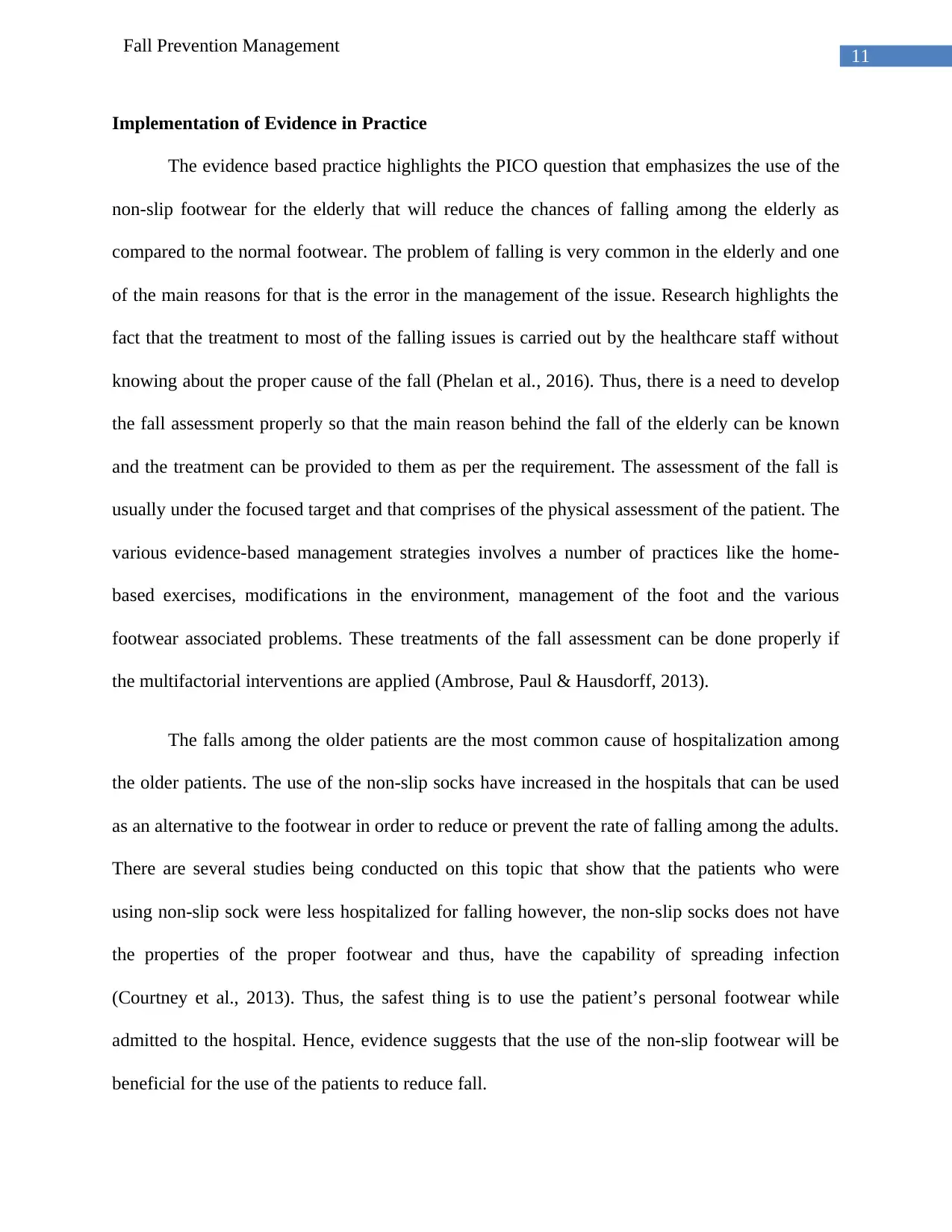
11
Fall Prevention Management
Implementation of Evidence in Practice
The evidence based practice highlights the PICO question that emphasizes the use of the
non-slip footwear for the elderly that will reduce the chances of falling among the elderly as
compared to the normal footwear. The problem of falling is very common in the elderly and one
of the main reasons for that is the error in the management of the issue. Research highlights the
fact that the treatment to most of the falling issues is carried out by the healthcare staff without
knowing about the proper cause of the fall (Phelan et al., 2016). Thus, there is a need to develop
the fall assessment properly so that the main reason behind the fall of the elderly can be known
and the treatment can be provided to them as per the requirement. The assessment of the fall is
usually under the focused target and that comprises of the physical assessment of the patient. The
various evidence-based management strategies involves a number of practices like the home-
based exercises, modifications in the environment, management of the foot and the various
footwear associated problems. These treatments of the fall assessment can be done properly if
the multifactorial interventions are applied (Ambrose, Paul & Hausdorff, 2013).
The falls among the older patients are the most common cause of hospitalization among
the older patients. The use of the non-slip socks have increased in the hospitals that can be used
as an alternative to the footwear in order to reduce or prevent the rate of falling among the adults.
There are several studies being conducted on this topic that show that the patients who were
using non-slip sock were less hospitalized for falling however, the non-slip socks does not have
the properties of the proper footwear and thus, have the capability of spreading infection
(Courtney et al., 2013). Thus, the safest thing is to use the patient’s personal footwear while
admitted to the hospital. Hence, evidence suggests that the use of the non-slip footwear will be
beneficial for the use of the patients to reduce fall.
Fall Prevention Management
Implementation of Evidence in Practice
The evidence based practice highlights the PICO question that emphasizes the use of the
non-slip footwear for the elderly that will reduce the chances of falling among the elderly as
compared to the normal footwear. The problem of falling is very common in the elderly and one
of the main reasons for that is the error in the management of the issue. Research highlights the
fact that the treatment to most of the falling issues is carried out by the healthcare staff without
knowing about the proper cause of the fall (Phelan et al., 2016). Thus, there is a need to develop
the fall assessment properly so that the main reason behind the fall of the elderly can be known
and the treatment can be provided to them as per the requirement. The assessment of the fall is
usually under the focused target and that comprises of the physical assessment of the patient. The
various evidence-based management strategies involves a number of practices like the home-
based exercises, modifications in the environment, management of the foot and the various
footwear associated problems. These treatments of the fall assessment can be done properly if
the multifactorial interventions are applied (Ambrose, Paul & Hausdorff, 2013).
The falls among the older patients are the most common cause of hospitalization among
the older patients. The use of the non-slip socks have increased in the hospitals that can be used
as an alternative to the footwear in order to reduce or prevent the rate of falling among the adults.
There are several studies being conducted on this topic that show that the patients who were
using non-slip sock were less hospitalized for falling however, the non-slip socks does not have
the properties of the proper footwear and thus, have the capability of spreading infection
(Courtney et al., 2013). Thus, the safest thing is to use the patient’s personal footwear while
admitted to the hospital. Hence, evidence suggests that the use of the non-slip footwear will be
beneficial for the use of the patients to reduce fall.
⊘ This is a preview!⊘
Do you want full access?
Subscribe today to unlock all pages.

Trusted by 1+ million students worldwide
1 out of 32
Related Documents
Your All-in-One AI-Powered Toolkit for Academic Success.
+13062052269
info@desklib.com
Available 24*7 on WhatsApp / Email
![[object Object]](/_next/static/media/star-bottom.7253800d.svg)
Unlock your academic potential
Copyright © 2020–2025 A2Z Services. All Rights Reserved. Developed and managed by ZUCOL.




